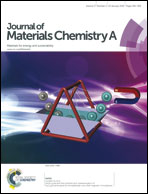Copper zinc tin sulfide as a catalytic material for counter electrodes in dye-sensitized solar cells†
Abstract
Quaternary Cu2ZnSnS4 (CZTS) semiconductor thin films, deposited onto an indium-doped tin oxide (ITO) conducting substrate by sulfurizing direct-current (DC) magnetron sputtered Cu–Zn–Sn metal alloys, were used as the counter electrode (CE) of dye-sensitized solar cells (DSSCs). X-ray diffraction (XRD) and Raman spectroscopy reveal that all the samples show the kesterite Cu2ZnSnS4 phase. The morphology becomes smoother for the Cu-rich or Zn-rich sample, as confirmed by atomic force microscopy (AFM) and field-emission scanning electron microscopy (FE-SEM). The influence of the [Cu]/[Zn] + [Sn] molar ratio in the CZTS samples on the catalytic performance of DSSCs was also investigated. The electrocatalytic ability and electrochemical properties of the CEs were studied by cyclic voltammetry (CV), electrochemical impedance spectroscopy (EIS), and Tafel plots. The performance of DSSCs with various CEs was verified by J–V curves and incident photon-to-current conversion efficiency (IPCE) curves. The maximum solar-to-electrical power efficiency of DSSCs using CZTS as the CE approached 7.94%. These results showed the attractive potential of CZTS to replace the Pt CE (8.55%). The influence of different molar ratios of CZTS CEs on the DSSC performance is discussed in detail.


 Please wait while we load your content...
Please wait while we load your content...